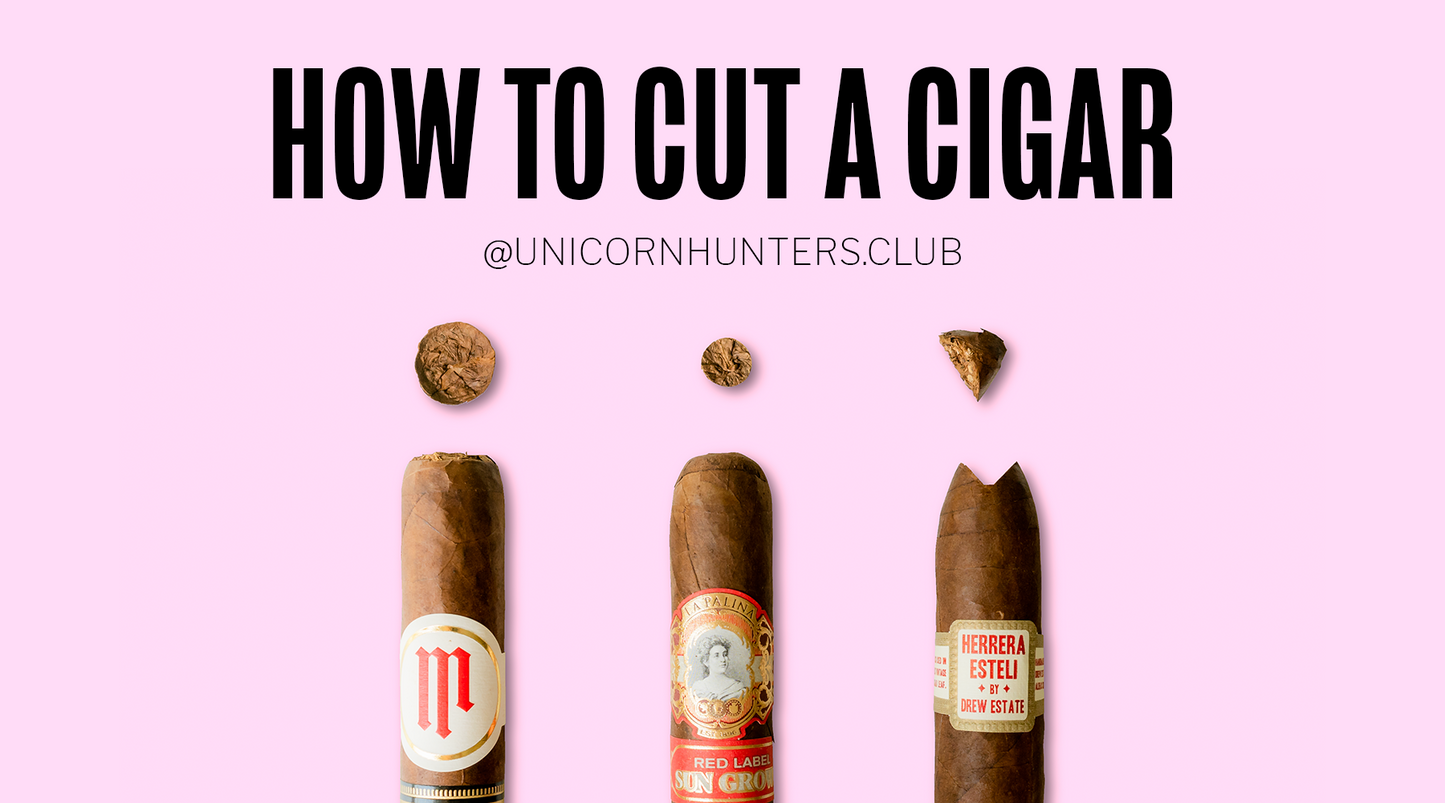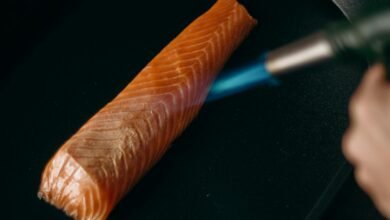How to Cut a Cigar: The Ultimate Guide for Aficionados

To cut a cigar, use a sharp cigar cutter to remove the cap at the head of the cigar, making a straight, clean cut. This step is essential to ensure a smooth draw and proper combustion of the cigar.
A well-cut cigar enhances the overall smoking experience, allowing the flavors and aromas to be fully enjoyed. Whether you are a seasoned cigar aficionado or new to the world of cigars, learning how to cut a cigar correctly is a skill worth mastering.
In this blog post, we will provide step-by-step instructions on how to cut a cigar and share some tips to help you achieve the perfect cut every time. So let’s dive in and discover the art of cutting a cigar.

Credit: unicornhunters.club
The Art Of Cigar Cutting
Essentials Of A Clean Cut
Cutting a cigar correctly is crucial for an optimal smoking experience.
- Sharp cutter
- Even pressure
- Proper technique
Tools Of The Trade
Having the right tools makes all the difference when cutting a cigar.
- Double-blade cutter
- Punch cutter
- V-cutter
Types Of Cigar Cutters
Cigar cutters come in various types, including guillotine, V-cut, and punch cutters. To ensure a smooth draw, it is essential to cut a cigar at the correct spot and angle.
When it comes to enjoying a cigar, proper preparation is key. One of the most important steps in the process is cutting the cigar. There are several types of cigar cutters available, each with their own unique method of cutting the cigar. Here are the most common types of cigar cutters and how they work.
Guillotine Cutters
The guillotine cutter is the most popular type of cigar cutter. It is a simple device that uses a straight blade to cut off the cap of the cigar. There are two types of guillotine cutters: single-bladed and double-bladed. The single-bladed cutter is the most basic and is ideal for beginners. The double-bladed cutter is a bit more advanced and is best for experienced cigar smokers.
V-cutters
V-cutters, also known as wedge cutters, are another popular type of cigar cutter. They are designed to make a small V-shaped cut in the cap of the cigar. This type of cut allows for a more concentrated draw and can enhance the flavors of the cigar. V-cutters come in both single and double-bladed versions.
Punch Cutters
Punch cutters are a unique type of cigar cutter that uses a small circular blade to punch a hole in the cap of the cigar. This type of cut is ideal for cigars with a smaller ring gauge. Punch cutters come in a variety of sizes and shapes, including round, square, and even bullet-shaped.
Scissors
While not as common as the other types of cigar cutters, scissors can be a useful tool for cutting cigars. They are especially useful for cutting cigars with a larger ring gauge. Scissors can be found in both straight and curved blade versions, and can be used to make a straight or angled cut.
In conclusion, choosing the right type of cigar cutter is an important part of enjoying a cigar. Whether you prefer a guillotine cutter, V-cutter, punch cutter, or scissors, each type has its own unique benefits and drawbacks. Experiment with different types of cutters to find the one that works best for you.
Selecting The Right Cutter
Choosing the right cutter is essential for a smooth and enjoyable cigar-cutting experience. The cutter you select will determine the precision of the cut, as well as your overall comfort while using it. To help you make an informed decision, consider evaluating the quality and precision, as well as the comfort and design considerations of the cutter.
Evaluating Quality And Precision
When selecting a cigar cutter, it’s important to assess its quality and precision. A well-crafted cutter will ensure a clean and precise cut, enhancing the smoking experience. Look for cutters made from durable materials such as stainless steel or high-quality metals, as they are likely to provide a sharp and reliable cutting edge. Additionally, check for any visible defects or signs of poor craftsmanship that may affect the cutter’s functionality.
Furthermore, consider the type of cut the cutter offers. Different cutters provide various cutting styles such as straight cuts, V-cuts, or punches. Each type has its own advantages and may vary based on personal preference. Take the time to understand the different cutting options and choose a cutter that aligns with your desired cigar-cutting style.
Comfort And Design Considerations
In addition to quality and precision, comfort and design play a crucial role in selecting the right cutter. A comfortable grip allows for easy handling and ensures a steady hand while cutting the cigar. Look for cutters with ergonomic designs and rubberized grips, as they offer enhanced comfort and control.
Consider the size and weight of the cutter as well. A compact and lightweight cutter is more portable and convenient to carry around, especially for those who enjoy cigars on the go. On the other hand, a larger and heavier cutter may provide a more substantial feel and stability during the cutting process.
Furthermore, examine the opening mechanism of the cutter. Some cutters feature spring-loaded or self-sharpening mechanisms, which can simplify the cutting process and enhance user experience. Assessing the ease of opening and closing the cutter will help determine its convenience and overall functionality.
By carefully evaluating the quality and precision, as well as considering the comfort and design aspects of a cigar cutter, you can select the right tool that will enhance your cigar-cutting experience. Remember, investing in a high-quality cutter will not only ensure a clean and precise cut but also contribute to the overall enjoyment of your smoking sessions.
Preparation Before The Cut
If you’re new to smoking cigars, you may not know the proper way to cut a cigar. A good cut is essential for a good draw, which in turn affects the taste and enjoyment of the cigar. Before you start cutting, there are a few steps you need to take to ensure that you’re prepared.
Inspecting The Cigar
The first step in preparing to cut your cigar is to inspect it. You want to make sure that the cigar is in good condition and doesn’t have any visible flaws or damage. Look for any cracks, holes, or discolorations that may affect the flavor and quality of the cigar. If you find any flaws, it’s best to set the cigar aside and choose a different one.
Understanding The Cigar Anatomy
Before you cut your cigar, it’s important to understand its anatomy. A cigar consists of three parts: the head, the body, and the foot. The head is the closed end that you will cut to create the draw. The foot is the open end that you will light. The body is the portion between the head and the foot.
The head of the cigar is the end that you will cut. It is covered by a small piece of tobacco called the cap. The cap holds the wrapper in place and prevents the tobacco from unraveling. When you cut the cigar, you want to avoid cutting into the body of the cigar and only cut off the cap.
Ensuring Proper Tools
Now that you have inspected your cigar and understand its anatomy, it’s time to make sure you have the proper tools to cut it. You will need a cigar cutter, which can come in several different types such as guillotine, v-cut, or punch. Choose the one that best suits your preference and experience. A dull cutter will damage the cigar and affect its flavor, so make sure your cutter is sharp.
It’s also a good idea to have a clean, flat surface to work on when cutting your cigar. This will prevent any damage to the cigar and make it easier to handle.
By inspecting your cigar, understanding its anatomy, and ensuring you have the proper tools, you are now ready to make the perfect cut. In the next section, we will discuss how to actually make the cut.
Mastering The Guillotine Cut
Mastering the Guillotine Cut is a key skill for any cigar enthusiast. This classic cut, also known as the straight cut, involves using a guillotine cutter to create a clean, precise cut that ensures a smooth draw and even burn. Understanding the proper positioning of the cutter and executing the cut with precision is essential for achieving the perfect straight cut.
Positioning The Cutter
When preparing to make a guillotine cut, hold the cigar firmly in one hand and position the blade of the cutter directly above the cap. Ensure the cap is perfectly aligned with the blade to create a straight and even cut. Maintain a steady grip on the cigar and the cutter to prevent any shifting during the cutting process.
Executing The Perfect Straight Cut
With the cutter in position, swiftly close the blades in one decisive motion. Avoid applying excessive force, as this can cause the cap to crack or the wrapper to unravel. A clean,
Achieving The V-cut
Achieving the perfect V-cut on a cigar requires precision and technique. Master the art of cutting a cigar with these simple steps to enhance your smoking experience.
Achieving the V-Cut When it comes to cutting a cigar, one popular technique is the V-Cut. This method involves creating a V-shaped notch at the cap of the cigar, allowing for a controlled and smooth draw. In this section, we will explore the angle and depth control required for a perfect V-Cut, as well as the benefits it offers. H3: Angle and Depth Control To achieve a precise V-Cut, it is essential to consider the angle and depth of the cut. The angle refers to the slope of the V-shaped notch, while the depth determines how far into the cap the cut should go.
To determine the optimal angle, position the blade of your cutter diagonally across the cap. Gently press the blades together and make a swift, decisive cut. Aim for an angle of approximately 45 degrees, ensuring that both sides of the V-Cut are symmetrical. When it comes to depth control, it’s crucial not to cut too shallow or too deep. A shallow cut may result in a tight draw, while a deep cut can cause the wrapper to unravel. Aim to cut just enough to expose the filler tobacco without compromising the integrity of the cigar. H3: Benefits of the V-Cut The V-Cut offers several benefits that make it a popular choice among cigar enthusiasts.
Here are some advantages of using this cutting method:1. Enhanced Draw: The V-shaped notch allows for a generous and smooth draw, ensuring a more enjoyable smoking experience. The opening created by the V-Cut provides a balanced airflow, allowing the flavors and aromas of the cigar to be fully appreciated. 2. Reduced Risk of Tobacco Bits: Unlike other cutting methods, such as the straight cut, the V-Cut minimizes the risk of small tobacco bits ending up in your mouth. The design of the V-notch helps contain the filler tobacco, preventing any loose debris from interfering with your smoking pleasure. 3. Preservation of Wrapper: The V-Cut helps preserve the integrity of the cigar’s wrapper.
By creating a clean, precise cut at the cap, you reduce the chances of the wrapper unraveling during the smoking process. This ensures that the cigar maintains its structural integrity and aesthetic appeal. In conclusion, achieving the perfect V-Cut requires careful consideration of the angle and depth of the cut. By following the recommended guidelines, you can enjoy a well-balanced draw and fully savor the flavors of your cigar. The V-Cut offers benefits such as enhanced draw, reduced risk of tobacco bits, and preservation of the wrapper. Experiment with this cutting technique to find the perfect V-Cut for your preferred smoking experience.
Using The Punch Cutter
When using the punch cutter to cut a cigar, it’s essential to master the proper technique for a clean cut. This method involves creating a small hole at the cap of the cigar to ensure a smooth draw and enhance the overall smoking experience.
Technique For A Round Punch
- Hold the punch cutter firmly against the cap of the cigar.
- Rotate the punch cutter into the cap to create a circular incision.
- Remove the piece of the cap gently to expose the filler tobacco.
When To Choose A Punch Cut
- Opt for a punch cut for smaller ring gauge cigars.
- Prefer a punch cutter for a cleaner and more concentrated draw.
- Use a punch cut for a milder smoking experience.

Credit: bovedainc.com
Cigar Cutting Etiquette
Cigar cutting etiquette is an essential aspect of enjoying a fine cigar. When handling a cigar cutter, it’s crucial to follow proper etiquette to ensure a smooth and enjoyable experience. Let’s delve into the do’s and don’ts of cigar cutting etiquette.
The Do’s And Don’ts
- Do use a sharp cutter to ensure a clean cut.
- Don’t bite or tear the end of the cigar.
- Do cut the cap off the cigar with a quick, decisive motion.
- Don’t cut too much off the end, as it can cause the wrapper to unravel.
- Do ensure the cutter is clean to prevent contaminating the cigar.
- Don’t use dull or improper tools for cutting.
Sharing Cutters With Fellow Aficionados
When sharing cutters, always sanitize the tool between uses. It’s important to respect others’ preferences and handle the cutter with care. Remember, a clean cutter ensures a better smoking experience for all aficionados.
Troubleshooting Common Cutting Mistakes
When cutting a cigar, it’s essential to do it correctly to ensure a smooth and enjoyable smoking experience. However, mistakes can happen, leading to issues such as a cracked wrapper or an uneven burn. Here’s how to troubleshoot these common cutting errors:
Dealing With A Cracked Wrapper
1. Inspect the cigar wrapper for any cracks or damage.
2. If you notice a crack, gently moisten the area with your tongue to help seal it.
3. Avoid excessive handling to prevent further damage to the wrapper.
Fixing An Uneven Burn
1. Rotate the cigar while puffing to promote an even burn.
2. Correct the burn by using a lighter to touch up the uneven areas.
3. Ensure an even cut next time to prevent future burn issues.

Credit: cigarcountry.com
Maintenance And Care For Cutters
When it comes to enjoying a good cigar, proper maintenance and care for your cutter are essential to ensure a clean and precise cut every time.
Cleaning Your Cutter
Regularly clean your cutter to prevent residue buildup that can affect the cut.
Sharpening The Blades
Blades should be sharpened annually for optimal performance.
Advanced Techniques And Tips
Once you have mastered the basics of cutting a cigar, you may want to explore some advanced techniques and tips that can enhance your smoking experience. These techniques allow you to experiment with different cuts and explore creative options that cater to experienced smokers. In this section, we will discuss two advanced techniques: experimenting with double cuts and creative cuts for experienced smokers.
Experimenting With Double Cuts
If you are looking to amplify the draw and flavor of your cigar, experimenting with double cuts can be a great option. This technique involves making two cuts at the head of the cigar instead of the traditional single cut. By creating a second cut, you can increase the airflow and expose more of the filler tobacco, resulting in a bolder and more robust smoking experience.
Here is a step-by-step guide to performing a double cut:
- Start by performing a standard straight cut about 1/16th of an inch from the cap of the cigar.
- Once the initial cut is made, make a second cut perpendicular to the first cut. This second cut should be slightly shallower to avoid damaging the wrapper.
- After the double cut is complete, check the draw by taking a test puff. If the draw feels too loose, you can make a third cut to adjust the airflow according to your preference.
Creative Cuts For Experienced Smokers
For experienced smokers who crave variety and enjoy experimenting with their cigars, creative cuts can add a new dimension to the smoking experience. These cuts can alter the way the cigar burns, intensify certain flavors, or create unique smoking sensations.
Here are a few creative cuts that you can try:
| Cut | Description |
|---|---|
| Punch Cut | A punch cut involves using a cigar punch to create a small hole in the cap of the cigar. This cut allows for a concentrated draw and can intensify the flavors. |
| V-Cut | A V-cut creates a V-shaped notch on the cap of the cigar. This cut provides a larger surface area for the smoke to pass through, resulting in a generous draw and enhanced flavors. |
| Shuriken Cut | The shuriken cut involves making multiple deep cuts around the cap of the cigar, resembling the shape of a shuriken throwing star. This cut can create unique burn patterns and intensify the smoking experience. |
Remember, experimenting with different cuts can be a personal preference, so feel free to explore and find the cutting technique that suits your taste and smoking style. Just make sure to handle your cigar carefully and use a sharp cutting tool to ensure a clean and precise cut.
Pairing Cuts With Cigar Types
Cutting a cigar is an art that requires precision and knowledge. Pairing the right cut with the type of cigar can enhance the overall smoking experience. Understanding the best cut for your cigar shape and how cutting can impact flavor and draw is essential for aficionados and beginners alike.
Best Cut For Your Cigar Shape
Choosing the best cut for your cigar shape is crucial to ensure an optimal smoking experience. Different cigar shapes, such as parejo, figurado, or torpedo, require specific cutting techniques to preserve their integrity and draw. For instance, a straight cut is ideal for parejo-shaped cigars, while a V-cut complements figurado or torpedo shapes.
Cutting For Flavor And Draw
The way a cigar is cut can significantly impact its flavor and draw. A straight cut allows for a more open draw, resulting in a cooler smoke, while a punch cut can concentrate the flavors for a more intense experience. Additionally, the depth of the cut can influence the draw, with a shallow cut offering a tighter draw and a deeper cut providing a more effortless draw.
Frequently Asked Questions
How Do You Cut A Cigar?
To cut a cigar, use a sharp cutter to remove the cap, leaving about 1/8 inch. Avoid cutting too much, as it can unravel.
What Tool Is Used To Cut A Cigar?
A cigar cutter, guillotine cutter, punch cutter, or cigar scissors are commonly used to cut a cigar. Each tool offers a different cutting experience and result.
What Is The Best Way To Cut A Cigar?
The best way to cut a cigar is to use a sharp, quality cutter and make a quick, clean cut. This ensures a smooth draw and prevents the cigar from unraveling.
Conclusion
Mastering the art of cutting a cigar is essential for a satisfying smoking experience. By using the right technique and tools, you can ensure a clean cut that enhances the flavors and draw of the cigar. Remember, practice makes perfect, so keep honing your cigar-cutting skills to enjoy the perfect smoke every time.





